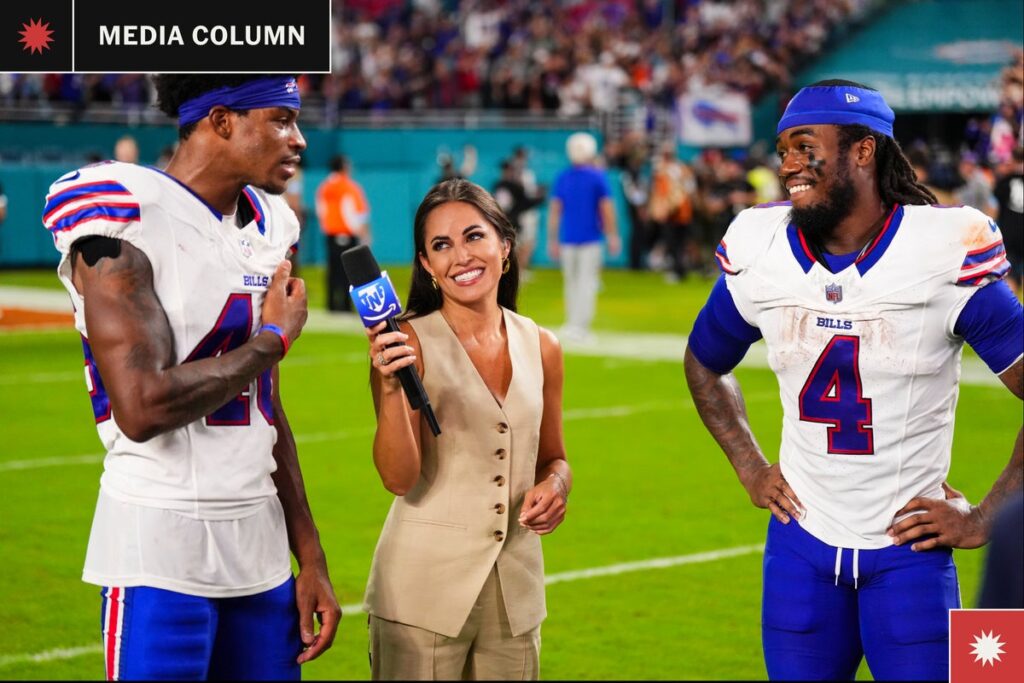It is not an accident that you are seeing more in-uniform interviews from NFL players this season. Here’s why: Last May, the NFL broadcasting department sent out a memo on the topic to the league’s chief executives, club presidents, general managers, head coaches and public relations directors. The memo outlined access changes for the NFL’s television partners after a review between the league and its media rights holders. The shared goal? To enhance the game content that we see as NFL viewers.
The key additions, as per the memo:
• In-game coach interviews for all games;
• Pregame player interviews for all games;
• Network pregame locker room coverage;
• Preseason player interviews;
• Coaches’ booth network cameras.
I’ll give you an example of how this has manifested itself for viewers so far. During the opening-week broadcast between the Cincinnati Bengals and New England Patriots, CBS sideline reporter Evan Washburn interviewed Cincinnati quarterback Joe Burrow right before kickoff. Home clubs must make a high-profile player available for pre-kick interviews in full uniform as part of the new broadcast access rules. (There are limits to the amount of interviews each player does with a network during the season, so it’s not one player doing it each week.)
“It always hits differently when you hear a player tell you things in his own voice,” said CBS Sports producer Ken Mack, who produces the CBS NFL team of Ian Eagle, Charles Davis and Washburn. “When Joe Burrow told Evan Washburn about how he ‘got a little emotional yesterday’ in the moments before the Bengals opener, it felt like it brought the audience closer to the player.”
“Got a little emotional yesterday, but I’m ready to go. Excited for it.”
Our @EvanWashburn caught up with @Bengals QB Joe Burrow before his first game in nearly 10 months pic.twitter.com/urkhZwGGpQ
— NFL on CBS (@NFLonCBS) September 8, 2024
The new access policy says clubs must make the head coach or either offensive or defensive coordinator available for in-game, on-camera interviews. The time slots are agreed upon between each club and the televising network prior to game day, and the home team has the first choice of interview timing between the end of first quarter, halftime, or the end of the third quarter. There are limits to the number of questions each coach can get (two) and where they take place.
NBC “Sunday Night Football” lead producer Rob Hyland said his broadcast has taken advantage of the new access initiatives. Through the first three games of the season, SNF has interviewed Kansas City Chiefs quarterback Patrick Mahomes, Detroit Lions wide receiver Amon-Ra St. Brown and Houston Texans quarterback C.J. Stroud prior to kickoff.
“We’ve also connected with each head coach, either at the start or end of halftime,” Hyland said. “One of Sunday Night Football’s stated goals is to take the viewer somewhere they have never been. Having the opportunity to speak with a player moments before kickoff or a head coach at halftime provides an additional layer of access for our audience that we believe adds to the overall viewer experience. Fans want to be as close to the stars of the game as possible.”
Jim Harbaugh handed out blue-collar shirts to his @chargers team to send a message.
Our @tracywolfson caught up with Derwin James about it just before kickoff. pic.twitter.com/j4nIYplKA1
— NFL on CBS (@NFLonCBS) September 8, 2024
You might have also noticed footage from the locker room coverage prior to the game. That’s part of the new access deal too. Per the memo: “When requested by televising network, clubs must record and share at least 20 seconds of pregame locker room footage or content with televising network each game. Recording must occur between conclusion of pregame warmups and 15 minutes prior to kickoff, with the Club having final approval on footage to be aired on broadcast.”
There are many NFL game days where you will see viewer complaints on social media about in-game interviews. The criticism usually revolves around the idea that coaches or players don’t provide insight or little is gleaned from the responses. Sure, sometimes that is valid criticism. But there are moments when viewers do get the occasional gem and insight. It’s why the networks will always support this: There is value in showing your viewers that you have unique access to the main people competing in the event.
“When a coach gives your reporter (and by extension your audience) insight into the team’s mindset at a crucial point in the game, that can be illuminating,” Mack said. “During that same Week 1 broadcast, Evan talked to (New England coach) Jerod Mayo at the start of the second quarter when the Patriots faced a third-and-goal from the Cincinnati 4-yard line. The conversation pushed the game’s storyline forward. Mayo’s forecast of continued aggressive play was borne out on the next play when the Patriots scored a touchdown to take the lead.”
Added Hyland: “Why wouldn’t you want fresh information from the individuals directly impacting the game? Hearing from the coaches and players in-game is something we will continue to showcase. On the rare occasion where some might think there isn’t much information gleaned, body language and non-verbal cues during the interview can be very telling and add to the story of what’s happening in the game.”
(Photo of Amazon “Thursday Night Football” sideline reporter Kaylee Hartung interviewing Buffalo Bills cornerback Ja’Marcus Ingram (left) and running back James Cook after their game last week: Cooper Neill / Getty Images)
https://www.nytimes.com/athletic/5768505/2024/09/20/nfl-broadcasters-cbs-nbc-espn-access-interviews/


